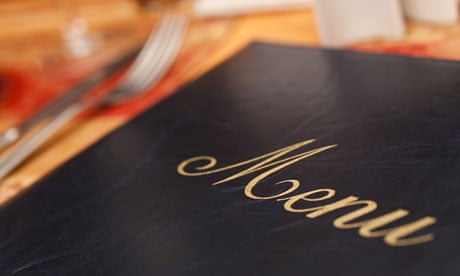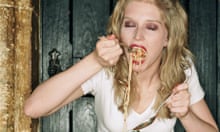It's not always easy trying to read a menu while hungry like the wolf, woozy from aperitif and exchanging pleasantries with a dining partner. The eyes flit about like a pinball, pinging between set meal options, side dishes and today's specials. Do I want comforting treats or something healthy? What's cheap? Will I end up bitterly coveting my companion's dinner? Is it immoral to fuss over such petty, first-world dilemmas? Oh God, the waiter's coming over.
Why is it so hard to decide what to have? New research from Bournemouth University shows that most menus crowbar in far more dishes than people want to choose from. And when it comes to choosing food and drink, as an influential psychophysicist by the name of Howard Moskowitz once said: "The mind knows not what the tongue wants."
Malcolm Gladwell cites an interesting nugget from his work for Nescafé. When asked what kind of coffee they like, most Americans will say: "a dark, rich, hearty roast". But actually, only 25-27% want that. Most prefer weak, milky coffee. Judgement is clouded by aspiration, peer pressure and marketing messages.
The burden of choice
Perhaps this is part of the joy of a tasting or set menu – the removal of responsibility. And maybe the recent trend for tapas-style sharing plates has been so popular because it relieves the decision-making pressure if all your eggs are not in one basket. Is there a perfect amount of choice?
Bournemouth University's new study has sought to answer this very question. "We were trying to establish the ideal number of starters, mains and puddings on a menu," says Professor John Edwards. The study's findings show that restaurant customers, across all ages and genders, do have an optimum number of menu items, below which they feel there's too little choice and above which it all becomes disconcerting. In fast-food joints, people wanted six items per category (starters, chicken dishes, fish, vegetarian and pasta dishes, grills and classic meat dishes, steaks and burgers, desserts), while in fine dining establishments, they preferred seven starters and desserts, and 10 main courses, thank you very much.
Nightmare menu layouts
Befuddling menu design doesn't help. A few years back, the author William Poundstone rather brilliantly annotated the menu from Balthazar in New York to reveal the marketing bells and whistles it uses to herd customers into parting with the maximum amount of cash. Professor Brian Wansink, author of Slim by Design, Mindless Eating Solutions to Every Day Life, has extensively researched menu psychology, or as he puts it, menu engineering. "What ends up initially catching the eye," he says, "has an unfair advantage over anything a person sees later on." There's some debate about how people's eyes naturally travel around menus, but Wansink reckons "we generally scan the menu in a z-shaped fashion starting at the top-left hand corner." Whatever the pattern, though, we're easily interrupted by items being placed in boxes, next to pictures or icons, bolded or in a different colour.
The language of food
The Oxford experimental psychologist Charles Spence has an upcoming review paper on the effect the name of a dish has on diners. "Give it an ethnic label," he says, "such as an Italian name, and people will rate the food as more authentic." Add an evocative description, and people will make far more positive comments about a dish's appeal and taste. "A label directs a person's attention towards a feature in a dish, and hence helps bring out certain flavours and textures," he says.
But we are seeing a backlash against the menu cliches (drizzled, homemade, infused) that have arisen from this thinking. For some time now, at Fergus Henderson's acclaimed restaurant, St John, they have let the ingredients speak for themselves, in simple lists. And if you eat at one of Russell Norman's Polpo group of restaurants in London, you will see almost no adjectives (or boxes and other "flim-flam", as he calls it), and he's doing a roaring trade. "I'm particularly unsympathetic to florid descriptions," he says.
However, Norman's menus employ their own, subtle techniques to reel diners in. Take his flagship restaurant Polpo's menu. Venetian dishes are printed on Italian butchers' paper, which goes with the distressed, rough-hewn feel of the place. I don't use a huge amount of Italian," he says, "but I occasionally use it so that customers say 'what is that?'" He picks an easy-to-pronounce word like suppli (rice balls), to start a conversation between diner and waiter.
Sound and atmosphere
Research has shown that classical music increases sales of expensive wines and overall spending in posh eateries, while French and German music increases sales of French and German wines, respectively (the diners are unaware of these influences). Slow music, and the scent of lavender, makes people spend longer in restaurants and pop music at 70-90dB will up the consumption of soft drinks. And, less surprisingly perhaps, in 1997 Edwards found that diners ate more at a breakfast buffet if the room smelled of grilled bacon, and less with the odour of boiled cabbage wafting around.
It's all relative, right? In his menu-deconstruction exercise, Poundstone refers to the £70 Le Balthazar seafood plate as a price anchor. "By putting high-profit items next to the extremely expensive anchor, they seem cheap by comparison." So, what the restaurant want you to get is the £43 Le Grand plate to the left of it. It's a similar story with wine. We'll invariably go for the second cheapest. Set menus, or "bundles", meanwhile, seem like good value and therefore give us an excuse to eat and spend more. Everyone's a winner.
Vast menus make me particularly nervous in, say, gastropubs, where they scream: "FRESH FROM THE DEEP FREEZE". And Norman finds any mention of "chef's special sauce" offputting (don't ask). What dampens your appetite on menus? And how do you decide what to order? Gut instinct, methodically weighed up pros and cons, eliminating items with unwanted ingredients? Or do you always just get the burger?







Comments (…)
Sign in or create your Guardian account to join the discussion